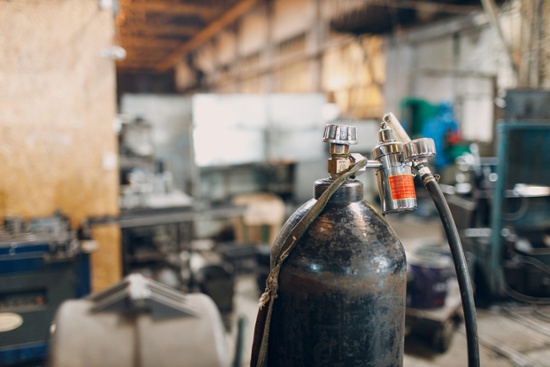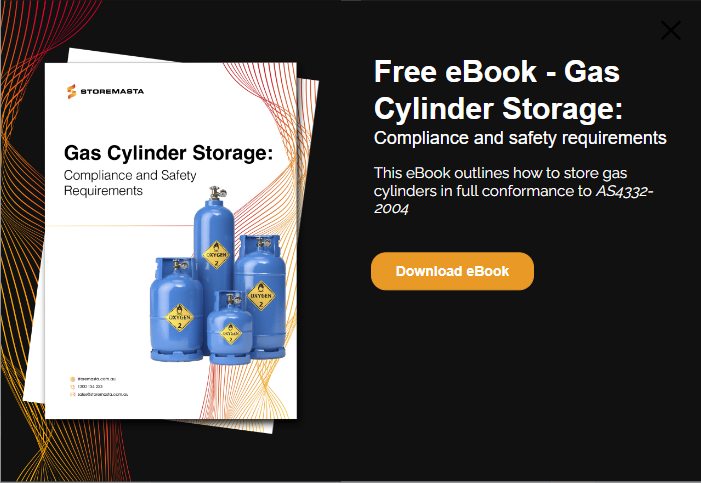Compressed gases stored under pressure in cylinders are recognised as dangerous goods. Therefore, gases stored in cylinders require careful storage, management and handling. This post presents a risk management methodology for improving gas cylinder safety at your workplace, so you can comply with Australia’s WHS legislation in your state or territory.
Risks and Hazards of Gas Cylinders
Compressed gas cylinders present a complex range of hazards. This is because compressed gas cylinders not only present chemical hazards, but the metal cylinder itself poses a range of physical hazards to the people and property of your workplace.
A gas cylinder, such as one which holds toxic gases, flammable gases or liquefied gases, will have a range of chemical hazards due to the properties of the dangerous goods. The gas cylinder will also have physiochemical hazards which are the result of the metal gas cylinder, as well as the compressed nature of the gas within.
We’ll look at both chemical and physiochemical hazards of gas cylinders in the next section of our post.
Chemical Hazards of Gases in Cylinders
Chemical hazards relate to the chemical properties of the gases – and the danger these properties pose to people, property and the environment.
Examples of chemical hazards associated with compressed gas in cylinders may include:
- Exposure to toxic and corrosive gases can quickly cause death or serious impairment.
- Liquified gases present a thermal hazard and can cause cold burns and frostbite injuries.
- Inert and flammable gases that leak into confined spaces can displace the oxygen in the atmosphere and asphyxiate anyone who enters the area.
- Oxidising gases can start or intensify fires and explosions.
- Flammable gases can ignite and cause catastrophic fires and explosions.
Physiochemical Hazards of Gas Cylinders
The physical properties of the cylinders and the way they are handled — in combination with the chemical properties of the gases – are explained as physiochemical hazards.

Gas cylinders have a complex range of hazards due to the chemical properties of the gases, as well as the physical properties of the cylinders.
Examples of physiochemical gas cylinder hazards may include:
- Manual handling injuries like sprains, strains and broken bones.
- Cylinders impacted by falling objects/vehicles; or dropped/knocked over by workers can rupture, leak, or explode.
- Cylinders exposed to heat can explode.
- Uncontrolled release of the high-pressure gas can create a torpedo-effect, critically injuring or killing impacted workers.
Importance of Conducting a Gas Cylinder Risk Assessment
To ensure gas cylinder safety in your workplace, you’ll need to conduct a full risk assessment before implementing suitable control measures.
Just like any dangerous goods or hazardous chemicals in your organisation, to ensure a safe working environment you must first determine what hazards are present in your workplace.
A risk assessment will then allow you to move on to the process of risk management, which allows for the implementation of various controls to mitigate gas cylinder risk.
Storemasta Risk Management Process
This gas cylinder risk assessment and management process is complex, at even the smallest worksite. So, that’s why our team here at Storemasta have developed an easy-to-understand 4-Step methodology to ensure your gas cylinder risks are controlled – and nothing gets missed.

Working through the risk management process in a cyclical manner will help you implement effective controls that remain suitable for your changing operations.
Let’s look at the gas cylinder risk assessment and management process in more detail, so you can implement it at your own workplace and control gas cylinder hazards.
IMPORTANT: To comply with WHS legislation in Australia you must ensure that each step in the Storemasta risk assessment methodology is completed in full AND in the chronological order outlined below. As a cyclical process, you will need to maintain this process to ensure all current risks are identified and all existing controls remain effective.
STEP 1: Identify Gases in Cylinders
You can’t control risks until you know what they are. Get started by identifying all the gases held at your worksite plus locating each and every cylinder. Walk around the worksite to physically locate the cylinders; liaising with people like floor staff, contractors and line managers as necessary. Using a sitemap is very helpful.
To correctly identify cylinders carefully check the cylinder labels and safety data sheets (SDSs).
Now you will make a list which identifies the:
- Gas types
- Cylinder types
- Tank capacity
- Quantities of gas cylinders
- Location of cylinders
- Details of how each gas cylinder is stored or handled
Now you have a master list of all gas cylinders at your site, you should collate the safety data sheets for each of them and begin writing down the hazards associated with each of the gases.
You might include things like: acetylene and O2 cylinders stored together overnight with the welding torch attached; or staff not using insulated gloves when changing LPG cylinders.
IMPORTANT: Don’t forget to include empty cylinders in your hazard identification process. Empty cylinders should be treated the same way as full cylinders.
STEP 2: Assess Gas Cylinder Risk
Once you have a master list of gas cylinders and collated the safety data sheets, you can begin assessing each of the hazards and the level of risk associated with each of them.
This is where you’ll examine:
- All the hazardous events that could occur (fires and explosions with flammable gases, dangerous gas leaks, chemical reactions with incompatible gases)
- The outcome of the events (fatalities, injuries, destruction of property, environmental damage)
- The likelihood of the event occurring
Hazards are then prioritised based on the how likely they are to cause an incident and the severity of the outcome.
Your risk assessment might examine a set of acetylene and O2 cylinders left on the gas bottle trolley overnight — with the welding torch still attached. These incompatible gases could easily ignite from static electricity or heat, causing a catastrophic explosion, possible deaths and property damage. This hazard would be prioritised for immediate attention.
STEP 3: Control Gas Cylinder Hazards
The Storemasta risk management methodology uses the Hierarchy of Control to systematically control each of the cylinder hazards identified in step 1.
Controlling gas cylinder hazards is made easier with compliant storage and handling equipment.
The 5 elements of the Hierarchy of Control should be considered in order during your gas cylinder risk assessment and risk management process.
- Elimination (how could you eliminate the hazard?)
- Substitution (is there another less harmful gas or work procedure that could be used?)
- Engineering controls (how could you redesign the workplace to reduce the amount of employees who are exposed to the cylinder hazards?)
- Administrative controls (what safe operating procedures could you implement?)
- Personal protective equipment (what protective equipment can be used to protect workers?)
IMPORTANT: PPE is the least effective control measure because it only places a barrier between the worker and the gas bottle hazard.
STEP 4: Sustain Gas Cylinder Safety
After working through the first 3 steps and implementing each control measure, you must now conduct another risk assessment to ensure that no new hazards have been created and that nothing has been missed. Step 4: Sustain is now about ensuring that your risk management is ongoing — and 100% compliance is sustained.
TIP: Need a Gas Cylinder Storage Risk Assessment? Reach out to our Storemasta Dangerous Goods Consultants for a tailored consultation on the storage and handling equipment required to improve gas cylinder safety in your operations. A storage risk assessment can help you better understand the hazards present in your workplace and how they can be mitigated through compliant gas cylinder storage solutions.
Gas Cylinder Risk Assessment
Would you like a more detailed look at the Storemasta methodology and how to use it to control the hazards associated with gas cylinders at your workplace? Download our free eBook Gas Cylinder Storage: Compliance and safety requirements to see the methodology applied using real-world examples and case studies. Read our guide to learn more about gas cylinder risk assessments and the practical ways that you can ensure gas cylinder safety today.

Living life by the 4 C’s of marketing – communication, coffee, compliance… and more coffee – Leisa Andersen is Storemasta’s Content Marketing Manager. When she’s not writing, you’ll find her enjoying all the good things in life, including shopping, travel and gluten free donuts.

